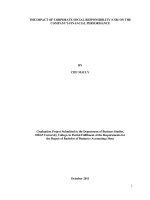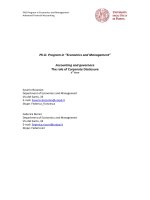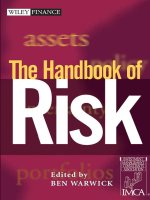The handbook of corporate financial risk management
Bạn đang xem bản rút gọn của tài liệu. Xem và tải ngay bản đầy đủ của tài liệu tại đây (5.96 MB, 413 trang )
Published in association with
As a result, corporations around the world
increasingly recognise the value in paying even
more attention to managing financial risks.
Hedging has become imperative.
But how exactly do you hedge financial risks? How
do you determine which risks to hedge first, and
which ones (if any) should be left unhedged?
The Handbook of Corporate Financial Risk Management,
written by Stanley Myint and Fabrice Famery of
BNP Paribas, addresses these problems, providing a
detailed guide to financial risks facing corporates.
This book is an essential resource for all risk
management professionals and practitioners
- treasurers, CFOs, CROs, CEOs, Financial
Directors, traders; accountants, consultants;
corporate bankers, coverage officers, corporate
financiers, private equity investors; academics and
students in the field of corporate risk management.
“This topical book could not have come at a better
moment. It illustrates the power of a systematic,
quantitative and analytical approach to financial
risk, which is even more important in these
turbulent times.”
THOMAS BARTELT, Head of Financial Risk
Controlling,Volkswagen
“This Handbook is rigorous, clear and ruthlessly
practical. Up-to-date examples are drawn from
the authors’ first-hand experience of meeting
their own clients’ complex needs. I can see this
becoming required reading for anyone involved
in managing corporate finance risk, and a key
reference in the field.”
DR HOWARD JONES, Senior Research Fellow in
Finance, Saïd Business School, Oxford University
“As a newly minted CFO this book, packed with
real life business cases, has been instrumental in
forming my views and action plan to address the
Group’s corporate risk. Highly recommended,
if not a must, read for students and business
professionals alike.”
ERIC HAGEMAN, Chief Financial Officer, KPN
Royal Dutch Telecom
“This unique book provides a comprehensive
overview of corporate risk management topics
and will prove to be very useful to Treasurers and
Financial Directors in their daily activities.”
ALESSANDRO CANTA, Head of Group
Finance, Enel
The Handbook of
Corporate
Financial
Risk
Management
By Stanley Myint & Fabrice Famery
By Stanley Myint & Fabrice Famery
A unique set of case studies draw on real-life
industry experience and the challenges treasurers
and treasuries face every day:
• Funding
• Interest rate and inflation risks
• Currency risk
• Credit risk
• M&A related risks
• Accounting and regulation
“…rigorous, clear and ruthlessly practical” - a
selection of praise for The Handbook of Corporate
Financial Risk Management:
The Handbook of Corporate Financial Risk Management
The financial crisis destroyed long-cherished
notions of risk and how to manage it. In its wake,
CFOs and Treasurers face a world where previous
assumptions are no longer sure to hold, markets
are becoming more unpredictable and no position
is risk free.
PEFC Certified
This book has been
produced entirely from
sustainable papers that
are accredited as PEFC
compliant.
www.pefc.org
tho_CFRM_BNPP.indd 1
Published in association with
19/10/2012 10:27
✐
✐
“myint” — 2012/10/18 — 17:47 — page i — #1
✐
✐
The Handbook of Corporate
Financial Risk Management
✐
✐
✐
✐
✐
✐
“myint” — 2012/10/18 — 17:47 — page ii — #2
✐
✐
✐
✐
✐
✐
✐
✐
“myint” — 2012/10/18 — 17:47 — page iii — #3
✐
✐
The Handbook of Corporate
Financial Risk Management
by Stanley Myint and Fabrice Famery
✐
✐
✐
✐
✐
✐
“myint” — 2012/10/18 — 17:47 — page iv — #4
✐
✐
Published by Risk Books, a Division of Incisive Media Investments Ltd
Incisive Media
32–34 Broadwick Street
London W1A 2HG
Tel: +44(0) 20 7316 9000
E-mail:
Sites: www.riskbooks.com
www.incisivemedia.com
© 2012 BNP Paribas
ISBN 978-1-906348-92-2
British Library Cataloguing in Publication Data
A catalogue record for this book is available from the British Library
Publisher: Nick Carver
Commissioning Editor: Sarah Hastings
Managing Editor: Lewis O’Sullivan
Editorial Development: Alice Levick
Designer: Lisa Ling
Copy-edited and typeset by T&T Productions Ltd, London
Printed and bound in the UK by Berforts Group
Conditions of sale
All rights reserved. No part of this publication may be reproduced in any material form whether
by photocopying or storing in any medium by electronic means whether or not transiently
or incidentally to some other use for this publication without the prior written consent of
the copyright owner except in accordance with the provisions of the Copyright, Designs and
Patents Act 1988 or under the terms of a licence issued by the Copyright Licensing Agency
Limited of Saffron House, 6–10 Kirby Street, London EC1N 8TS, UK.
Warning: the doing of any unauthorised act in relation to this work may result in both civil
and criminal liability.
Every effort has been made to ensure the accuracy of the text at the time of publication, this
includes efforts to contact each author to ensure the accuracy of their details at publication
is correct. However, no responsibility for loss occasioned to any person acting or refraining
from acting as a result of the material contained in this publication will be accepted by the
copyright owner, the editor, the authors or Incisive Media.
Many of the product names contained in this publication are registered trade marks, and Risk
Books has made every effort to print them with the capitalisation and punctuation used by the
trademark owner. For reasons of textual clarity, it is not our house style to use symbols such
as TM, ®, etc. However, the absence of such symbols should not be taken to indicate absence
of trademark protection; anyone wishing to use product names in the public domain should
first clear such use with the product owner.
While best efforts have been intended for the preparation of this book, neither the publisher,
the editor nor any of the potentially implicitly affiliated organisations accept responsibility
for any errors, mistakes and or omissions it may provide or for any losses howsoever arising
from or in reliance upon its information, meanings and interpretations by any parties.
✐
✐
✐
✐
✐
✐
“myint” — 2012/10/18 — 17:47 — page v — #5
✐
✐
For
Sarah, Marko, Nora and Milica
Sandrine, Edouard, Elisa and Victoria
✐
✐
✐
✐
✐
✐
“myint” — 2012/10/18 — 17:47 — page vi — #6
✐
✐
BNP PARIBAS CORPORATE & INVESTMENT BANKING
BNP Paribas Corporate & Investment Banking is one of the world’s
pre-eminent investment banks, with expertise spanning fixed income, structured finance, global equities, commodity derivatives
and corporate finance. We are part of a global banking group that,
in the first half of 2012, generated a net income of EUR 4.7 billion
on EUR 20.0 billion of revenue, demonstrating persistent strength
despite a challenging economic environment.
The fixed income division boasts world-class research and strategy, debt capital markets and corporate solutions teams offering,
among others, risk management solutions across interest rates and
foreign exchange, as well as debt management strategies.
It is one of the world’s leading partners for bond issuers and
investors: for EUR-currency bond issues, BNP Paribas Corporate
& Investment Banking has been ranked “No. 1 Lead Manager” by
volume every year since 2009, while, for corporate EMEA bond
issues (all currencies), it ranked no. 1 in 2009, 2010 and 2012 to date
(Thomson Reuters).
The Corporate Solutions Group is a team comprising 25 professionals, whose mandate is to assist key corporate clients of BNP
Paribas on strategic issues related to funding and risk management.
vi
✐
✐
✐
✐
✐
✐
“myint” — 2012/10/18 — 17:47 — page vii — #7
✐
✐
INDUSTRY ACCOLADES
Euromoney Interest
Rates Survey 2012
EuroWeek Awards
2012
Euromoney Awards
for Excellence 2012
No.1 EUR
Derivatives for
Corporates
Best Bank for:
Corporate DCM in
EUR (1st)
Corporate DCM in
USD (3rd)
Best Debt House in
Western Europe
Best Bank in Western
Europe
vii
✐
✐
✐
✐
✐
✐
“myint” — 2012/10/18 — 17:47 — page viii — #8
✐
✐
✐
✐
✐
✐
✐
✐
“myint” — 2012/10/18 — 17:47 — page ix — #9
✐
✐
Contents
About the Authors
Foreword
Preface
Introduction
PART I
FUNDING
xiii
xv
xvii
xix
1
Funding
3
1
How to Obtain a Credit Rating
9
2
The Intermediated Exchange
19
3
Cash Tender Offer
27
4
Optimal Debt Duration via Merton’s Model
33
5
Funding Cost Drivers
41
PART II
INTEREST RATE AND INFLATION RISKS
51
Interest Rate and Inflation Risks
53
6
How to Develop an Interest Rate Hedging Policy
57
7
How to Improve Your Fixed–Floating Mix and Duration
69
8
Impact of Fixed–Floating Policy on Company Valuation
93
9
Do You Need Inflation-Linked Debt?
107
10 Prehedging Interest Rate Risk
117
11 When to Prehedge
127
12 Constrained Maturity Optimisation
141
13 Asset and Liability Management
147
14 Pension Fund Asset and Liability Management
159
ix
✐
✐
✐
✐
✐
✐
“myint” — 2012/10/18 — 17:47 — page x — #10
✐
✐
THE HANDBOOK OF CORPORATE FINANCIAL RISK MANAGEMENT
PART III
CURRENCY RISK
Currency Risk
167
169
15 How to Develop a Foreign Exchange Hedging Policy
175
16 Netting Foreign Exchange Risks
185
17 Managing the Risk from Emerging Market Currencies
199
18 Currency Risk on Covenants
207
19 How to Manage Translation Risk
215
20 Managing Foreign Exchange Risk with a Dynamic Option
Strategy
227
PART IV
239
CREDIT RISK
Credit Risk
241
21 Counterparty Risk Methodology
245
22 Counterparty Risk Protection
255
23 Optimal Deposit Composition
263
24 Prehedging Credit Risk
277
PART V
285
M&A-RELATED RISKS
M&A-Related Risks
287
25 Rating Impact of an Acquisition
293
26 Risk Management for M&A
299
27 Amendments to Bond Documentation
313
28 Monetising Deferred Consideration
317
29 Hedging Uncertain Exposures
323
PART VI
337
COMMODITY RISK
Commodity Risk
339
x
✐
✐
✐
✐
✐
✐
“myint” — 2012/10/18 — 17:47 — page xi — #11
✐
✐
CONTENTS
30 Managing Commodity-Linked Revenues and Currency Risk
345
31 Managing Commodity-Linked Costs and Currency Risk
353
References
360
Index
363
xi
✐
✐
✐
✐
✐
✐
“myint” — 2012/10/18 — 17:47 — page xii — #12
✐
✐
✐
✐
✐
✐
✐
✐
“myint” — 2012/10/18 — 17:47 — page xiii — #13
✐
✐
About the Authors
Stanley Myint heads the risk management advisory team at BNP
Paribas and has 18 years of experience in this field. The mandate of
the team is to advise key corporate clients of BNP Paribas on issues
related to financial risk management, particularly with regards to
interest rate, currency, inflation and credit risk. His approach is a
mixture of quantitative finance and corporate finance. Prior to BNP
Paribas, Stanley worked at The Royal Bank of Scotland, McKinsey
& Company and Canadian Imperial Bank of Commerce, always in
the field of risk management. He has published several articles in
Risk Books publications and Risk magazine. Stanley has a PhD in
physics from Boston University and a BSc in physics from Belgrade
University (Serbia).
Fabrice Famery is head of rates and FX corporate sales for Western
Europe at BNP Paribas. His group provides corporate clients with
hedging solutions across interest rate and foreign exchange asset
classes. Corporate risk management has been the focus of Fabrice’s
professional path for the past 24 years. He spent the first seven years
of his career in the treasury department of the energy company ELF,
then, in 1996, joined Paribas (now BNP Paribas), where he occupied
various positions including FX derivative marketer, head of the FX
advisory group and head of the fixed income corporate solutions
group. Fabrice has published articles in Finance Director Europe and
Risk magazine. He has a Master’s degree in international affairs from
Dauphine University (France).
xiii
✐
✐
✐
✐
✐
✐
“myint” — 2012/10/18 — 17:47 — page xiv — #14
✐
✐
✐
✐
✐
✐
✐
✐
“myint” — 2012/10/18 — 17:47 — page xv — #15
✐
✐
Foreword
The Handbook of Corporate Financial Risk Management has the rare
quality of delivering exactly what its title promises.
Over the years, managing financial risks has represented an everincreasing share of the workload of any chief financial officer (CFO),
and this is unlikely to reverse any time soon. Our world has become
more risky and more complex. This is a fact.
To highlight one example of various financial risks, the figure
below illustrates the performance of copper, freight, short-term interest rates and the EURUSD exchange rate, since 1994:
Freight
Copper
Eonia
EURUSD
1994
1995
1996
1997
1998
1999
2000
2001
2002
2003
2004
2005
2006
2007
2008
2009
2010
2011
2012
1,000
900
800
700
600
500
400
300
200
100
0
Companies around the world are affected by these and numerous
other market variables, and risk managers have to tackle them all
in order to lessen their impacts on financial results and the financial
position of their firm.
Among the many sins closely associated with bankers, one of
the most frequently cited is opacity. This book will encourage you
to revisit this cliché. Stanley Myint and Fabrice Famery have conducted a thorough analysis of the many financial risks facing companies and, most importantly, of how to identify, measure, reduce
or eliminate them. Some are obvious, such as interest risk; some are
more intricate, such as the risk of deferred consideration in an M&A
transaction, or counterparty risk.
xv
✐
✐
✐
✐
✐
✐
“myint” — 2012/10/18 — 17:47 — page xvi — #16
✐
✐
THE HANDBOOK OF CORPORATE FINANCIAL RISK MANAGEMENT
Having spent thousands of days thinking about how to help companies address financial risks that they sometimes have not even
identified, about how to present solutions in a clear way that is easy
to understand, and about how to outsmart the competition and win
advisory mandates from clients, Stanley and Fabrice are now able to
deliver this handbook, ie, a book that presents issues and solutions.
All are example based and very pragmatic. No chapter is complete
before a recommendations paragraph being included.
Stanley and Fabrice are successful in business because their clients
continue to appreciate their ideas. They have the ability to identify areas of academic research that can be of use for solving new
problems or opening new fields such as optimal debt duration or
the impact of fixed–floating policy on company valuation. To these
problems they apply academic rigour and often advanced analytical techniques, eg, Monte Carlo simulations or efficient frontier
methodology.
The end result is very clear and readable, and I have no doubt that
financial managers, once they have read this book, will keep it close
at hand, as I myself did with previous unpublished versions when I
was working as an M&A specialist. Advanced finance students will
discover an intellectually challenging world in which there are so
many different situations that boredom is never an issue. They may
even be tempted to start their professional careers in this expanding
field.
Enjoy this handbook; it is likely to be one of your best investments
ever!
Pascal Quiry
BNP Paribas Professor of Finance at HEC Paris
September 2012
xvi
✐
✐
✐
✐
✐
✐
“myint” — 2012/10/18 — 17:47 — page xvii — #17
✐
✐
Preface
Risk. Human life is uncertain, and risk arguably defines the human
condition, but as individuals or groups we do everything in our
power to predict and reduce it; yet in the context of the world’s most
turbulent peacetime financial outlook in something like 80 years, risk
now seems intensely heightened for many global corporations and
financial institutions. Assumptions have been turned upside down,
models and paradigms undermined or even abandoned; flagship
companies have foundered, and confidence in major institutions has
been weakened and in some cases shattered.
In our business, in the businesses of those we seek to serve, the
name of the game is financial risk. Where risk is excessive, or not
approached with sufficient prudence and rigour, or simply misunderstood, share prices fall, pensions suffer, people suffer; in the most
extreme cases, international stability is weakened and nation states
themselves can be shaken.
It is therefore ironic, surely, that corporate risk is not more written about and better understood. This book has come about because
the authors feel there is a gap in the published analysis of corporate
risk. In the introduction to the book we detail the existing literature
on the subject (and indeed we hope this book will be read alongside good existing material, to create a broad understanding of the
issues, and to that end we have provided an outline of what existing
literature is in our opinion likely to prove valuable to professional
risk managers); nevertheless, we believe that, while much literature
exists covering risk management in the financial sector, there is relatively little covering risk in the corporate sector. And while risk is
certainly well understood in many large companies, the same does
not hold true for many smaller, privately held companies.
Into this space, we offer our analysis. It is based not on remote,
abstract or esoteric dimensions of risk, but on several years’ detailed
analysis, by practitioners, of hundreds of real-life risk situations
faced by many of the world’s top corporations. If there is one main
message of the book, it is this: financial risks, no matter how serious, can be analysed and managed using a systematic quantitative
approach, described in these pages. We hope it is not arrogant for
xvii
✐
✐
✐
✐
✐
✐
“myint” — 2012/10/18 — 17:47 — page xviii — #18
✐
✐
THE HANDBOOK OF CORPORATE FINANCIAL RISK MANAGEMENT
us to suggest that a practical, rigorous, thoroughly researched and,
we hope, clearly written guide may illuminate the subject of risk for
anyone who is touched by the issue of corporate risk management.
If, in these troubled times, we have helped clarify and even reduce
financial risk for just a few of our readers, we will feel our efforts
have been worthwhile.
xviii
✐
✐
✐
✐
✐
✐
“myint” — 2012/10/18 — 17:47 — page xix — #19
✐
✐
Introduction
Every day I know what my sales are, what my profit margin is and
what my debt is. Anything I do not know, I hedge.
CFO of a Swiss multinational company
MOTIVATION FOR THIS BOOK
This book is wholly based on real-life client discussions we had
in the corporate solutions group at BNP Paribas between 2005 and
2012. During this period, we noticed that corporate treasurers and
chief financial officers (CFOs) often have similar questions on risk
management, and that these questions are rarely addressed in the
existing literature.
This situation can and should lead to a fruitful collaboration between companies and their banks. Companies often come up with
the best ideas, but do not have the resources to test them. Leading banks, on the other hand, have strong computational resources,
a broader sector perspective and extensive experience in internal
risk management, so if they make an effort to understand a client’s
problem in depth, they may be able to add considerable value.
This book is the result of such an effort, lasting seven years and
covering several hundred of the largest European corporations from
all industrial sectors.1 Its subject is corporate financial risk management, ie, the management of financial risks for non-financial
corporations.
While there are many papers on this topic, they are generally
written by academics and rarely by practitioners. If we contrast this
with the subject of risk management for banks, on which many books
have been written from the practitioners’ perspective, we notice a
significant gap. Perhaps this is because financial risk is clearly a more
central part of business among banks and asset managers than in
non-financial corporations. But, even if this is true, it does not mean
that financial risk is only important for banks and asset managers.
Let us look at one example.
Consider a large European automotive company, with an operating margin of 10%. More than half of its sales are outside Europe,
xix
✐
✐
✐
✐
✐
✐
“myint” — 2012/10/18 — 17:47 — page xx — #20
✐
✐
THE HANDBOOK OF CORPORATE FINANCIAL RISK MANAGEMENT
while its production is predominantly in EUR. This exposes the company to currency risk. Annual currency volatility is of the order of
15%; therefore, if the foreign currencies fall by 15%, this can almost
wipe out the net profits.2 Clearly, an important question for this
company is how to manage the currency risk.
Another example: a European investment grade telecom operator has EUR 10 billion in total debt. Annual interest cost for this
company can easily exceed 5% of its debt, ie, EUR 500 million per
year. As the interest rate curves are normally upward-sloping, the
company has a choice of fixing the debt, which normally results in
a higher interest rate, or leaving the debt floating, in which case the
interest rate risk is higher. The choice, normally referred to as the
fixed–floating proportion, is not an easy one, and again is evidently
important for the company.
Another reason why corporate risk management has so far attracted relatively little attention in the literature is that, even though
the questions asked are often simple (eg, “Should I hedge the translation risk?”) the answers are rarely simple, and in many cases there
is no generally accepted methodology on how to deal with these
issues.
So where does the company treasurer go to find answers to these
kinds of questions? General corporate finance books are usually very
shy when it comes to discussing risk management. Two famous
examples of such books devote only 20–30 pages to managing financial risk, out of almost 1,000 pages in total.
This does not mean that the subject of corporate risk management
has been entirely neglected in the literature. There are a couple of
books (and many articles) which cover this topic and we will now
briefly review some of them.
OVERVIEW OF THE LITERATURE
We are aware of five books on corporate financial risk management
(CFRM) in English (for details see the bibliography). In addition,
there are many academic articles, and we apologise to their authors
and our readers that space prevents us from listing them all here,
but we will mention some of them in the text.
The literature on CFRM takes one of the following four formats.
xx
✐
✐
✐
✐
✐
✐
“myint” — 2012/10/18 — 17:47 — page xxi — #21
✐
✐
INTRODUCTION
1. Theory of CFRM: conditions under which risk management
adds value in companies (ie, when it reduces the tax or probability of financial distress or when it improves company’s
investment decisions); how much risk should a company have
and similar issues.
2. Practice of CFRM: how specific techniques and products (for
instance, credit derivatives or interest rate swaps) are used in
companies to manage financial risks.
3. Surveys of CFRM: periodic surveys performed by academic
institutions, in which a sample of companies is asked multiplechoice questions about various aspects of their risk management practice.
4. Case studies: concrete examples of how companies manage
their financial risks.
First, there are three book-length compilations of articles, which
have mostly been published previously in various journals:
1. Brown and Chew (1999) covers all four areas.
2. Jameson (1997) focuses on practice.
3. Culp and Miller (1999) is devoted to theory and practice (with a
particular focus on the Metallgesellschaft derivative loss from
1993).
In addition to these anthologies, there are two books which are based
on original material:
1. Triana (2006) focuses on practical uses of derivatives among
corporations.
2. Leautier (2007) focuses on the theory, particularly of risk capital.3
SCOPE OF THE BOOK
So how does the present volume fit within the existing literature?
Our book is entirely devoted to real-life case studies of companies
managing financial risk, but also provides our views on the best
way to deal with those situations. So the book is partly descriptive, but largely prescriptive. The reader will find here answers to
the most commonly asked practical questions about financial risk.
Some of the situations will be brief (eg, how to obtain a credit rating)
xxi
✐
✐
✐
✐
✐
✐
“myint” — 2012/10/18 — 17:47 — page xxii — #22
✐
✐
THE HANDBOOK OF CORPORATE FINANCIAL RISK MANAGEMENT
and some will require a significant amount of thought and detailed
quantitative analysis (eg, how to improve your fixed–floating mix
and duration), but all are real-life situations that our clients have
faced over the years.
The focus of the book is management of financial risks, ie, primarily currency, interest rates, inflation, credit and commodity risks. We
do not cover non-financial risks (eg, business and operational risks),
which are normally outside of the scope of the financial department. We do not talk about insurance contracts; nor do we focus
on equity derivatives, since they are outside the day-to-day experience of most financial treasuries. The reader interested in the use
of equity derivatives for corporate risk management should consult
Ramirez (2011).
Finally, we do not spend a lot of time explaining the details of
financial derivatives, for two reasons. First, most corporate treasurers and CFOs are familiar with few basic types of financial derivatives, which tend to get a hedge accounting treatment under IAS 39.
These are FX forwards and options, interest rate and cross-currency
swaps, interest rate caps and collars. There are many books which
extol the virtues of more complex derivatives, but in our experience the latter are rarely used by companies, for a variety of reasons
including the inability to price and risk-manage them, unfavourable
accounting treatment and relative illiquidity in comparison with the
basic products. This does not mean that structured products should
be excluded from the toolbox of a corporate risk manager, but (as we
discuss in Chapter 6 on “How to Develop an Interest Rate Hedging
Policy”), they should always be compared with simpler products.
Only if the simpler product does not satisfy the same genuine purpose as the structured one should the latter’s use be considered.
Second, this book is primarily about corporate problems and how
to solve them. Most of the time, we noticed that the key question is
not what kind of product (whether it is a derivative or a cash instrument) is used, but how it is used. For us, derivatives are just one of
the means by which a corporate risk can be reduced, but nothing
more.
CORPORATE GOVERNANCE
There are several well documented cases in which a company did
not manage its financial risks properly and ended up losing a lot of
xxii
✐
✐
✐
✐
✐
✐
“myint” — 2012/10/18 — 17:47 — page xxiii — #23
✐
✐
INTRODUCTION
money as a result. Some of the earlier ones are described in Culp
and Miller (1999) and Triana (2006), but even today, and probably
in the future, there will be similar misuses of derivatives that attract
public attention for the wrong reason.
We strongly feel that these situations should be put into perspective. Most companies manage their financial risks prudently, and
this is never reported. The only time that financial risk management gets media attention is when there is a significant loss. This
is similar to the bias in reporting of airline safety; every incident is
publicised and scrutinised, while millions of uneventful flights are
never mentioned, because they are, well, uneventful.
Perhaps this is normal, and extreme aversion to corporate risk is
understandable and can be explained by the general public’s lack of
understanding of this field coupled with the fear we all have of the
things we don’t understand.
Nevertheless, we should probably say a few words about why
derivatives scandals (yes, they normally have to do with derivatives!) are thankfully so rare, and how these incidents can be avoided
as much as possible.
First, large public companies who manage their financial risk
using derivatives tend to have well-designed risk management processes, which codify the applicable policies and provide strict guidance on the use of derivatives. We talk more about how to develop
interest rate and FX hedging policies in Chapters 6 and 15, but the
main purpose of these policies is to give the financial department
sufficient freedom to implement the risk management policy while
not giving them “too much freedom”.
Second, in our experience, corporate treasurers, CFOs and other
risk management professionals in large companies normally tend
to be very experienced and equipped with a significant amount of
common sense when it comes to dissecting more adventurous risk
management ideas. They will very rarely accept a proposal that they
do not understand. Even if they are convinced that a given solution
genuinely reduces the company’s financial risk profile, they will only
propose it to their boards if they are convinced that they can explain
it to them.
Unfortunately, the same process does not always hold in small,
privately held companies (even though in some of them we met first
class risk managers and financial decision-makers).
xxiii
✐
✐
✐
✐
✐
✐
“myint” — 2012/10/18 — 17:47 — page xxiv — #24
✐
✐
THE HANDBOOK OF CORPORATE FINANCIAL RISK MANAGEMENT
BENCHMARKING RISK MANAGEMENT PERFORMANCE
One of the questions that is not asked as often as it should be is:
“how do we know whether what we are doing is right?” This can
be in regards to any kind of corporate policy, but in the context of
this book the two most obvious areas of examination are the interest
rate and currency risk management policies.
Why do we think that this question should be asked more often?
First, in most companies we know, the financial department can
have more impact than any other department, generally with minimal resources. We have illustrated how big this impact can be in
the two examples at the beginning of this introduction. So then, it
is natural to ask the question for the benefit of both the financial
department and other key decision-makers in the company.
Second, company policy normally evolves over time, and if the
existing policy is not appropriate, it should be changed, but this can
be done only if the policy is in some way contrasted to its alternatives.
In any case, many financial treasurers and CFOs talk to their peers
at other companies and already have a sense of how their policy
is different. The point of benchmarking is simply to formalise this
process and provide an independent objective comparison that can
be used for review and performance measurement.
So how do we go about constructing a benchmark? Now that
we have argued that benchmarking is necessary, we have to admit
that it is not easy or obvious how to create a good benchmark. We
mention this in the two chapters on risk management policy, but in
our experience there are several pitfalls.
• The benchmark has to be risk adjusted. For instance, if one
company has a policy to float most of its debt, while another
leaves its debt largely fixed, the expected interest cost of the
two cannot be compared directly. A fixed interest rate policy is
generally more expensive, but also less risky (for more details,
see Chapter 7).
• Back-testing of corporate policies is a tricky business. For ex-
ample, a policy to hedge currency exposure to EURJPY can
be benchmarked in terms of the average rate achieved over
a given period. However, the conclusions will very much depend on the period in question. A company treasurer once
asked our views on how to benchmark their actual historical
xxiv
✐
✐
✐
✐









